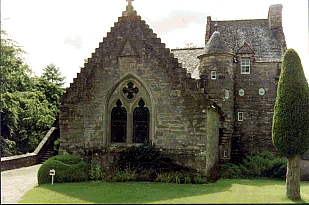by Susan Flantzer
The second wife of David II, King of Scots, Margaret Drummond was born in Perthshire, Scotland in about 1330. She was the daughter of Sir Malcolm Drummond, a minor Lennox and Perthshire lord, and his wife from the Graham family, possibly named Annabelle. In 1314, Sir Malcolm fought at the decisive Battle of Bannockburn, a landmark in Scottish history. Stirling Castle, a Scots royal fortress, occupied by the English, was under siege by the Scottish army. King Edward II of England, who was at the battle, assembled a formidable force to stop the siege. This attempt failed, and Edward II’s army was defeated by a smaller army commanded by Robert I the Bruce, King of Scots. Sir Malcolm is credited with the use of caltrops at the battle, a weapon made up of two or more sharp nails or spikes arranged in such a manner that one of them always points upward from a stable base to injure horses and unseat their riders. The caltrops were spread on the ground prior to the Battle of Bannockburn and were very effective against the English horses. After the battle, the Clan Drummond was given lands in Perthshire by Robert I the Bruce, King of Scots. In memory of Malcolm’s feat, caltrops appear in many versions of the Drummond coat of arms and the Clan Drummond motto is “Gang Warily” (Go carefully).

Crest badge for Clan Drummond; Credit – CC BY-SA 3.0, https://commons.wikimedia.org/w/index.php?curid=17521683
Margaret had at least one sibling:
- Sir John Drummond of Stobhall (born circa 1300 – died circa 1360), married Mary de Montfichet, daughter and co-heiress with her sisters of Sir William de Montfichet, of Stobhall, Cargill, and Auchterarder, had issue including Annabelle Drummond who married John Stewart, Earl of Carrick (the future Robert III, King of Scots), son of Robert II, King of Scots

Sir Malcolm Drummond, a son of Margaret’s brother, obtained the clan home, Stobhall Castle, seen above, from Margaret after she became Queen of Scots; Photo Credit – By Andrew Mitchell, CC BY-SA 2.0, https://commons.wikimedia.org/w/index.php?curid=9211639
Margaret first married Sir John Logie, and the couple had a son John of Logie, born about 1350. As very young children, David II, King of Scots, son of Robert I the Bruce, King of Scots from his second marriage, and Joan of the Tower, daughter of King Edward II of England, were married under the terms of the peace which ended the Wars of Scottish Independence which were fought between Scotland and England. The marriage was unhappy and childless, and David had mistresses. Around 1360, David and Margaret began an affair.

David II of Scotland (left) and Edward III of England (right); Credit – Wikipedia
In 1362, Joan of the Tower died, leaving David free to marry Margaret, who had lived with him for some time. Around 1363, either Margaret’s first husband died or her first marriage was annulled and David and Margaret made plans to marry. However, the marriage plans provoked a rebellion by supporters of David’s nephew and heir presumptive Robert Stewart, High Steward of Scotland. Robert was the only child of Marjorie Bruce, daughter of Robert the Bruce by his first wife Isabella of Mar. The rebels eventually submitted and on February 20, 1364, David and Margaret married at Inchmurdoch, the manor of the Bishop of St. Andrews near Crail, Scotland.
History has depicted Margaret as beautiful, but also arrogant and greedy. As Queen of Scots, Margaret received land in Perthshire and the customs revenue from Aberdeen and Inverkeithing. She also managed to procure royal lands in Annandale for her son John of Logie. Margaret pressed her husband into stripping his first cousin William, 5th Earl of Ross of his lands and title and briefly arresting his heir presumptive Robert Stewart, High Steward of Scotland.
By 1368, Margaret’s behavior and her failure to produce an heir had convinced David to annul their marriage. Instead, he planned to marry his current mistress Agnes Dunbar. David had the marriage annulled on March 20, 1369, on grounds of Margaret’s infertility. However, Margaret traveled to Avignon, in southern France, and made a successful appeal to the Pope Urban V to reverse the annulment which had been pronounced against her in Scotland. Since Margaret had a child in her first marriage, it seems likely that David himself was infertile, since his thirty-four-year marriage to his first wife was childless. David never did marry Agnes Dunbar. He died unexpectedly on February 22, 1371, at Edinburgh Castle and was buried at Holyrood Abbey in Edinburgh, now in ruins. His nephew, the son of his half-sister Marjorie, succeeded him as Robert II, King of Scots, the first monarch of the House of Stewart. Around 1373, Margaret died in Marseilles, France. Pope Gregory XI paid for her funeral and burial. Her burial place is unknown, but it is assumed it is in France.
Wikipedia: Margaret Drummond, Queen of Scotland
Works Cited
- “Clan Drummond”. En.wikipedia.org. N.p., 2017. Web. 7 Apr. 2017.
- “David II Of Scotland”. En.wikipedia.org. N.p., 2017. Web. 7 Apr. 2017.
- Ewan, Elizabeth et al. The Biographical Dictionary Of Scottish Women. 1st ed. Edinburgh: Edinburgh University Press, 2007. Print.
- “Margaret Drummond: Genealogics”. Genealogics.org. N.p., 2017. Web. 7 Apr. 2017.
- “Margaret Drummond, Queen Of Scotland”. En.wikipedia.org. N.p., 2017. Web. 7 Apr. 2017.
- “Marguerite Drummond”. Fr.wikipedia.org. N.p., 2017. Web. 7 Apr. 2017.
